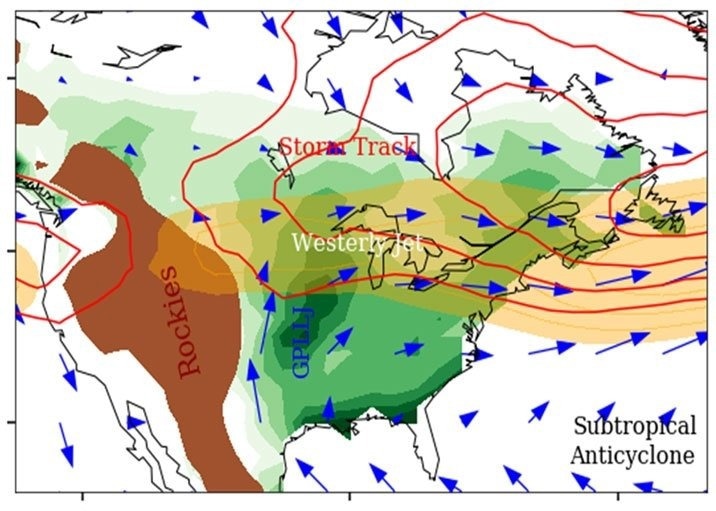Understanding how global warming affects regional precipitation is a significant challenge. Although midwestern regions of the United States are currently receiving a lot of rain, climate models are uncertain about future changes in the Midwest's rainy season rainfall.
 The warm-season central U.S. hydroclimate is regulated by two major systems—the midlatitude storm track (red contours) and the subtropical southerly winds (blue arrows). Both are coupled to the westerly jet (yellow shading). Image Credit: Zhou, W., et al. © Copyright 2022 AMS.
The warm-season central U.S. hydroclimate is regulated by two major systems—the midlatitude storm track (red contours) and the subtropical southerly winds (blue arrows). Both are coupled to the westerly jet (yellow shading). Image Credit: Zhou, W., et al. © Copyright 2022 AMS.
The pivotal role of a poleward jet shift in steering seasonally dependent changes in precipitation in the Midwest of the United States has been revealed. The jet is the North American westerly jet, which is a powerful and narrow wind belt. The research reveals that future mean precipitation in the Midwest rainy season will not differ substantially from present precipitation.
The Impact
The Midwest of the United States is one of the world’s most important agricultural regions. As a result, how its climate and water cycle react to global warming will have substantial societal and economic consequences. Extremely wet late springs and extremely dry late summers are expected to become more common as precipitation patterns change. This increases the Midwest’s risk of late-spring deluges and late-summer droughts.
Summary
Pacific Northwest National Laboratory researchers investigated the response of the United States’ Midwest hydroclimate to global warming using both the Coupled Model Intercomparison Project (CMIP) Phase 6 and the Initial-condition Large-ensemble Simulations.
Hydroclimate research combines hydrology and climate to investigate how water moves through the Earth’s ecosystem and its interactions with climate and weather on a variety of scales.
According to the study, future hydroclimate changes in the Midwest will result in more precipitation in April and May but less precipitation in July and August. These patterns are driven by the warming-induced poleward jet shift, which boosts low-level southerly winds in late spring but curtails weather disturbances, or the storm track, in late summer.
The impact of the poleward jet shift can be compared to the seasonal progression of the climate. Because of global warming, the westerly jet is shifting poleward, bringing more precipitation to the Midwest before June. The jet moves away from the Midwest after June, resulting in less precipitation.
Extremely wet late springs and extremely dry late summers will become more common in a warmer future. Under a high emission scenario, a once-in-a-century event in the historical period could become a once-every-decade event by the end of this century. Earlier projections that only looked at the rainy season mean obstructed the severity of such climate impacts.
The research was funded by the Department of Energy Office of Science, Biological and Environmental Research program as part of the Regional and Global Model Analysis and Multi-Sector Dynamics program areas. The U.S. CLIVAR (Climate and Ocean: Variability, Predictability, and Change) Working Group on Large Ensembles provided the Multi-LENS archive. The investigators acknowledge the World Climate Research Program Working Group on Coupled Modeling, which is responsible for the CMIP.
Journal Reference:
Zhou, W., et al. (2022) Seasonally Dependent Future Changes in the U.S. Midwest Hydroclimate and Extremes. Journal of Climate. doi.org/10.1175/jcli-d-21-0012.1.